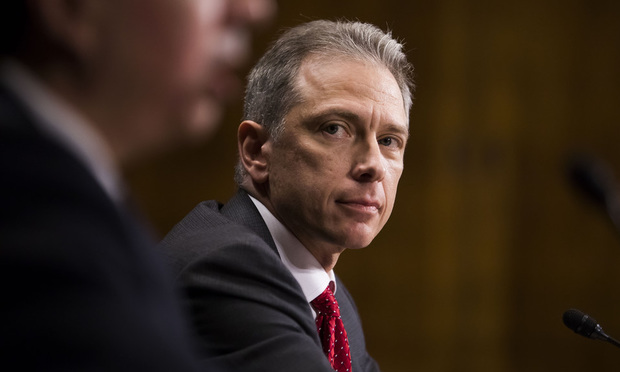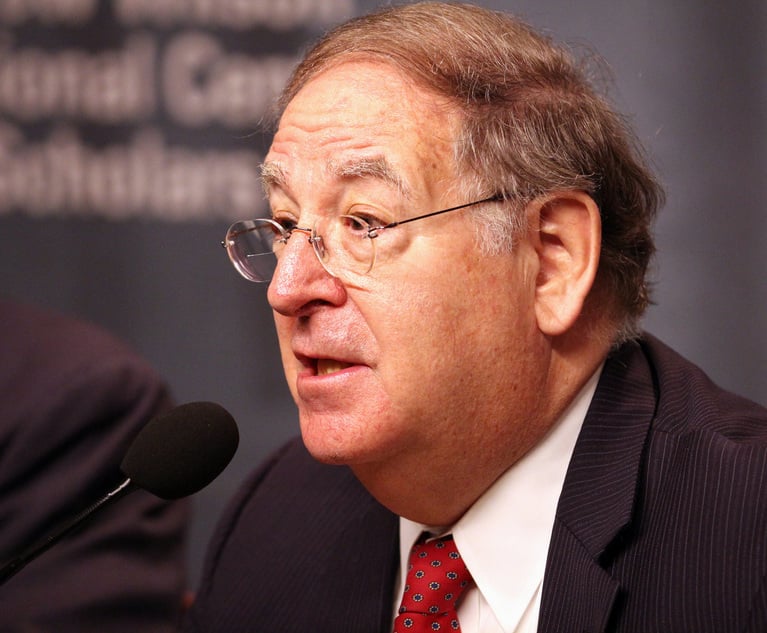PTO Director: 'Something Must Be Done' to Clarify Section 101
In a speech to the U.S. Chamber of Commerce Andrei Iancu also promised wide-ranging review of Patent Trial and Appeal Board operations and standards.
April 11, 2018 at 06:40 PM
5 minute read

New USPTO Director Andrei Iancu is getting more specific in his ideas for reforming the patent system.
Speaking to the U.S. Chamber of Commerce Wednesday, Iancu said the U.S. Patent and Trademark Office is conducting a broad review of the administrative procedure for challenging patent validity at the PTO, known as inter partes review.
“We are now examining: how and when we institute proceedings, the standards we employ during the proceedings, and how we conduct the overall proceedings,” Iancu said in prepared remarks. “The goal, with whatever action we take, is to increase predictability of appropriately scoped claims.”
The comments seemed to confirm recent speculation that the claim construction standard the Patent Trial and Appeal Board (PTAB) uses in inter partes review is on the chopping block. That standard, known as broadest reasonable interpretation or BRI, has been criticized by patent owners as contributing to too many invalidations.
Patent owners want the board to use the somewhat more narrow Phillips standard employed by federal courts. The U.S. Supreme Court rejected a challenge to BRI in 2016, but made clear that the PTO has authority to adopt a different standard.
Iancu also ramped up his criticism of the Supreme Court's patent eligibility jurisprudence, a series of four decisions that culminated in 2014's Alice v. CLS Bank. The rulings have led to a lot of debate among district judges and within the U.S. Court of Appeals for the Federal Circuit as to what is an unpatentable abstract idea under Section 101 of the Patent Act.
“System-wide, a significant amount of time is being spent trying to figure out where the lines should be drawn, and what's in and what's out. And multiple people looking at the same patent claims often have trouble agreeing on, and predicting, the outcome,” Iancu said. “Something must be done.”
Iancu stressed that the PTO will respect Supreme Court teachings, but said it will look for ways to simplify the guidance it provides to its patent examiners. “The USPTO can lead, not just react to every new case the courts issue,” he said.
Finnegan, Henderson, Farabow, Garrett & Dunner partner Erika Arner said she's pleased Iancu is focusing on predictability. Lawyers, patent owners and the public benefit from settled expectations, as even the Supreme Court has noted.
Arner, the president of the PTAB Bar Association, said PTAB Chief Judge David Ruschke also has been emphasizing predictability. It's a challenge for a bench that numbers more than 100 administrative judges. The goal is not to have broad patent rights “turn on the whim of one panel or the fact-specific circumstances of one case,” she said.
She pointed out that Ruschke has organized a June 29 judicial conference where stakeholders can give feedback directly to members of the board.
Arner said Iancu's mention of “standards” could refer to BRI or to the In re Packard standard of indefiniteness used in post-grant reviews. That too is also different from the standard used in federal courts. The PTO recently withdrew as an intervenor in a case where the agency had been defending the Packard standard, saying its “actively reconsidering” its stance.
Scott Kamholz, a Covington & Burling of counsel who previously served as a PTAB judge, agreed that tighter claim construction standards appear to be on the horizon. “My sense is that he is not focused on harmonizing outcomes at the PTAB and district court, but rather to give both the PTAB and district judges more basis to rely on each other's claim constructions,” Kamholz said. “That will save duplicated effort and could help parties make less speculative decisions about initiating proceedings in either forum.”
The PTO did not immediately respond to a request for clarification about which standards Iancu was referring to.
Drinker Biddle & Reath partner Robert Stoll, who took in Iancu's speech in person, welcomed the comments on Section 101. “The Supreme Court cases themselves say they're to be narrowly interpreted,” said Stoll, a former commissioner of patents at the PTO. Just as the Federal Circuit has to figure out ways to make the law work in practice, so too does the PTO when patents are being issued. “He's saying 'I will interpret, and I will interpolate, those decisions to come up with better guidance for the examiners,'” Stoll said.
As he often does, Iancu told the story of an individual inventor—in this case SanDisk co-founder Eli Harari—to illustrate the potential rewards of properly incentivized innovation. “The rhetoric surrounding the patent system has focused relentlessly on certain faults in, or abuses of, the system—instead of the incredible benefits the system brings to our nation,” Iancu said.
Stoll said he considered that message important. “He's saying, 'If you like the patent system, quit saying it's terrible,'” he said. “'Let's work to fix it, but the patent system is the best thing we've got.'”
This content has been archived. It is available through our partners, LexisNexis® and Bloomberg Law.
To view this content, please continue to their sites.
Not a Lexis Subscriber?
Subscribe Now
Not a Bloomberg Law Subscriber?
Subscribe Now
NOT FOR REPRINT
© 2025 ALM Global, LLC, All Rights Reserved. Request academic re-use from www.copyright.com. All other uses, submit a request to [email protected]. For more information visit Asset & Logo Licensing.
You Might Like
View All
Read the Document: DOJ Releases Ex-Special Counsel's Report Explaining Trump Prosecutions
3 minute read
Crypto Exchange’s ‘Meteoric Rise’ Leads to Nationwide Class Action Trend
4 minute read
Veteran Federal Trade Law Enforcer Joins King & Spalding in Washington
4 minute read
'Thoughtful Jurist': Maryland US District Senior Judge Messitte Dies After Short Illness
4 minute readTrending Stories
- 1DOT Nominee Duffy Pledges Safety, Faster Infrastructure Spending in Confirmation Hearing
- 2'Younger and Invigorated Bench': Biden's Legacy in New Jersey Federal Court
- 3'Every Single Judge on Board': First-Impression Case Revived
- 4NYSBA Annual Meeting: How In-House Counsel Navigate Gen AI Risk
- 5A Judge Ordered Squabbling Lawyers to Have Lunch: Here's What Happened
Who Got The Work
J. Brugh Lower of Gibbons has entered an appearance for industrial equipment supplier Devco Corporation in a pending trademark infringement lawsuit. The suit, accusing the defendant of selling knock-off Graco products, was filed Dec. 18 in New Jersey District Court by Rivkin Radler on behalf of Graco Inc. and Graco Minnesota. The case, assigned to U.S. District Judge Zahid N. Quraishi, is 3:24-cv-11294, Graco Inc. et al v. Devco Corporation.
Who Got The Work
Rebecca Maller-Stein and Kent A. Yalowitz of Arnold & Porter Kaye Scholer have entered their appearances for Hanaco Venture Capital and its executives, Lior Prosor and David Frankel, in a pending securities lawsuit. The action, filed on Dec. 24 in New York Southern District Court by Zell, Aron & Co. on behalf of Goldeneye Advisors, accuses the defendants of negligently and fraudulently managing the plaintiff's $1 million investment. The case, assigned to U.S. District Judge Vernon S. Broderick, is 1:24-cv-09918, Goldeneye Advisors, LLC v. Hanaco Venture Capital, Ltd. et al.
Who Got The Work
Attorneys from A&O Shearman has stepped in as defense counsel for Toronto-Dominion Bank and other defendants in a pending securities class action. The suit, filed Dec. 11 in New York Southern District Court by Bleichmar Fonti & Auld, accuses the defendants of concealing the bank's 'pervasive' deficiencies in regards to its compliance with the Bank Secrecy Act and the quality of its anti-money laundering controls. The case, assigned to U.S. District Judge Arun Subramanian, is 1:24-cv-09445, Gonzalez v. The Toronto-Dominion Bank et al.
Who Got The Work
Crown Castle International, a Pennsylvania company providing shared communications infrastructure, has turned to Luke D. Wolf of Gordon Rees Scully Mansukhani to fend off a pending breach-of-contract lawsuit. The court action, filed Nov. 25 in Michigan Eastern District Court by Hooper Hathaway PC on behalf of The Town Residences LLC, accuses Crown Castle of failing to transfer approximately $30,000 in utility payments from T-Mobile in breach of a roof-top lease and assignment agreement. The case, assigned to U.S. District Judge Susan K. Declercq, is 2:24-cv-13131, The Town Residences LLC v. T-Mobile US, Inc. et al.
Who Got The Work
Wilfred P. Coronato and Daniel M. Schwartz of McCarter & English have stepped in as defense counsel to Electrolux Home Products Inc. in a pending product liability lawsuit. The court action, filed Nov. 26 in New York Eastern District Court by Poulos Lopiccolo PC and Nagel Rice LLP on behalf of David Stern, alleges that the defendant's refrigerators’ drawers and shelving repeatedly break and fall apart within months after purchase. The case, assigned to U.S. District Judge Joan M. Azrack, is 2:24-cv-08204, Stern v. Electrolux Home Products, Inc.
Featured Firms
Law Offices of Gary Martin Hays & Associates, P.C.
(470) 294-1674
Law Offices of Mark E. Salomone
(857) 444-6468
Smith & Hassler
(713) 739-1250










